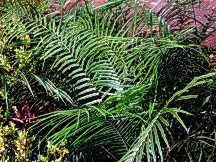
The Best of the Rest
Articles gleaned from other publications
that should not be missed
Pteris vittata
The danger of arsenic leaching from treated woods into children's play areas has made the news in South Florida recently. The problem of the heavy metal, arsenic, in the soil is much wider than this, of course, since it is a by-product of many industrial and mining activities, and has been a common component of weed killers and pesticides.
This has led to research on
ways of cleaning soil, including one very promising avenue of work at
the University of Florida that uses a common tropical fern, Pteris
vittata or ladder brake, with the ability to extract arsenic from
soil and store it in its leaves. The research was reported in the February
1st issue of Nature, but more accessible to most of us is a summary
in American Nurseryman of 15th March 2001.
| The fern has a staggering ability to extract and concentrate arsenic from the soil. On one contaminated site with 38.9 parts per million (ppm) of arsenic in the soil, the fern's fronds had 7,526 ppm of arsenic, and under experimental conditions where soil was loaded with arsenic, the fern accumulated 22,630 ppm of the heavy metal. |
 |
|
Mature plant of Pteris vittata
|
Even where the arsenic concentration in the soil is low, the fern will seek it out and suck it up: a soil on the university campus with just 0.47 ppm produced a fern with 136 ppm or arsenic in its fronds.
The promise appears to be high for subtropical areas where this fern will thrive. Once the plants are established, the concentration of the heavy metal in the leaves begins, and they can be harvested periodically for disposal in some safe facility. The ferns are even an attractive addition to the landscape.
To read more about this study, go to http://www.napa.ufl.edu/2001news/fern.htm
And for an introduction to this whole science of using plants for soil clean-up (phytoremediation), visit http://www.epa.gov/tio/download/citizens/citphyto.pdf .
[ Editor: In a follow-up letter in the May 1st issue of American Nurseryman one remediation company reports that they are already using the fern. Unfortunately they have trademarked one source of the plant, and have the arrogance to claim to be sole suppliers. This may be true of the trademarked item, but the fern grows freely in South Florida, and will be easily produced by any nursery that cares to get into the business by collecting plants or growing their own from spores.]
Orchid repotting
Many of the popular orchids are epiphytic, growing widespreading roots that give a firm grip on branches and trunks of trees. When we hold these wild creatures captive, they are very obliging in most respects, but do insist on growing roots to suit their pleasure rather than accepting our wishes for a neat appearance. If I may paraphrase the old saw that governs my approach to order in my office, " a tidy pot is a sign of a sick orchid."
Now that orchids are being grown much more widely, many people are flummoxed by what to do when it is time to repot. I found a marvellous set of instructions with good pictures at Jim's Orchid Supplies http://www.jimssupplies.com/pottingguide.html. Browse the rest of his site for growing supplies, then click the back button on your browser to come back to us here.
Gardening for Hummingbirds
We must all have had a hummingbird experience of some kind, even if only watching a documentary on television. As wonderful as the photographers for these programs are, and the best of them are fantastic in their ability to bring us closer to the birds than we could ever hope to be in our gardens, there is still nothing that quite compares with flesh and blood experience of the high whir of wingbeats and the flash of color that announces the presence of one of these little miracles of flight.
Arnette Heidcamp, writing in the May/June issue of The American Gardener brings us closer to being able to organise this experience in our own gardens. She reviews the distribution of this family of New World birds, reminding those of us in the hummingbird-deprived eastern United States (a single species) that the West is much better off with 14 species nesting or passing through at various times of the year.
What will bring this cast of performers into your garden? Lots of native plants that the birds have become used to using, plus as many non-natives that provide nectar in attractive flowers as you can fit in. The flower-form that has probably evolved with the hummingbirds is tubular, with nectar deep enough inside to be reached by the bird's tongue, but a little out of range of most insects. Think of shrimp plant, salvia and cypress vine to picture this shape. Red is apparently a color seen well by the birds, but neither another color nor a different form will necessarily exclude a flower from being attractive to them. Petunias, fuchsia, pentas, lantana and morning glories are all valuable nectar sources that are much appreciated over a long period of flowering.
Should you supplement the flowers' bounty with artificial feeders? The author thinks that this is well worth while, and has full instructions on how to make them most effective.
Check the May/June issue of The American Gardener, the magazine of the American Horticultural Society for the full text and illustrations. There is a new book, Ortho's All About Attracting Hummingbirds and Butterflies, which strikes me as a very good introduction to the subject at a very reasonable price.
Back to Table of Contents